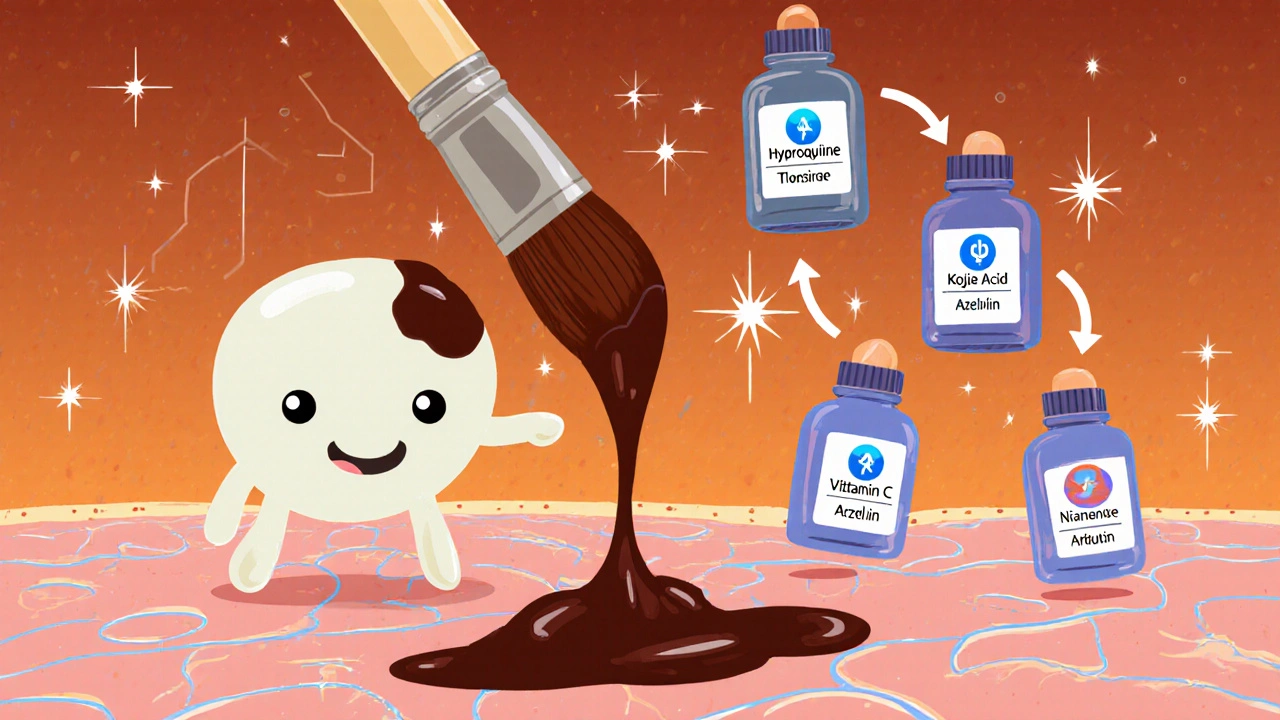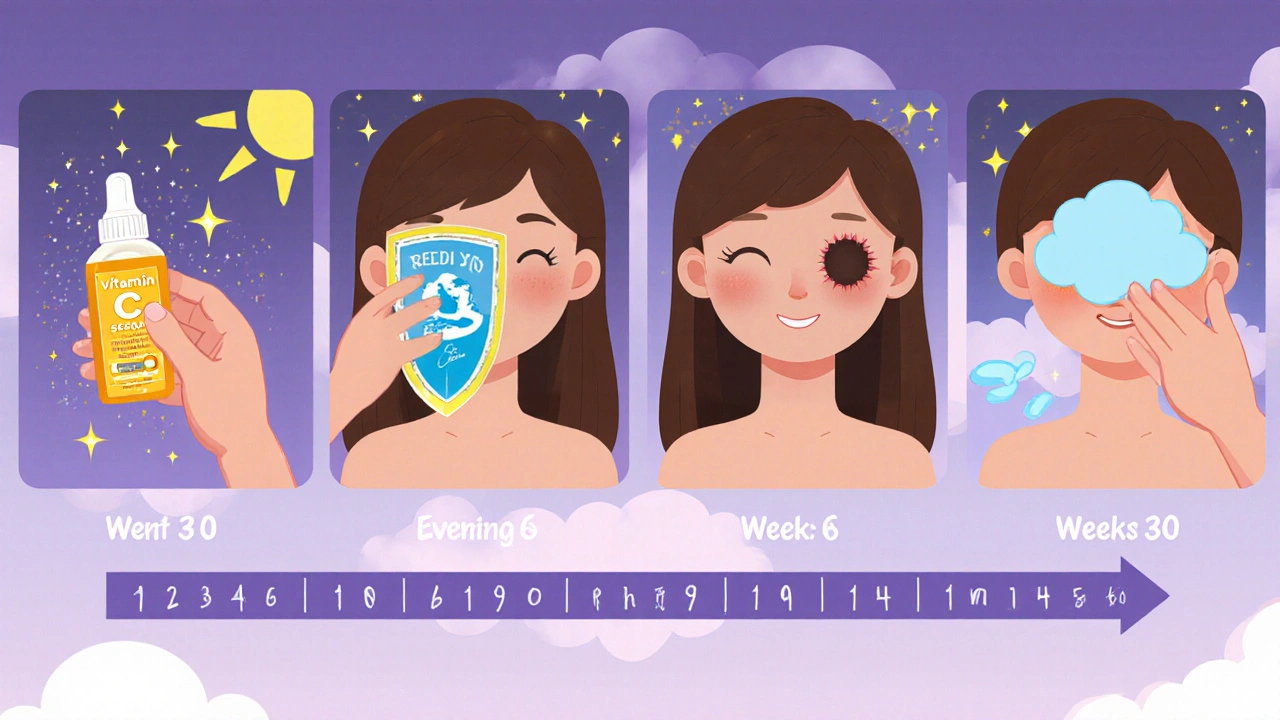
When it comes to tackling dark spots, melasma, or post‑inflammatory hyperpigmentation, the market is flooded with creams, serums, and prescriptions. Most people wonder whether the classic hydroquinone still holds the crown or if newer ingredients can deliver the same fade with fewer side effects. This guide breaks down the science, safety, and real‑world performance of the most common skin‑lightening agents, so you can decide which one fits your skin type and goals.
All depigmenting agents aim to curb melanin, the pigment that gives skin its color. Melanin is produced by melanocytes through a cascade that starts with the enzyme tyrosinase converting the amino acid tyrosine into dopa and then into melanin. Interrupt any step in that pathway, and the visible darkness fades.
Because the pathway is well‑mapped, researchers have been able to develop agents that work at different points:
Below are the agents most frequently recommended by dermatologists and found in over‑the‑counter (OTC) formulas.
Hydroquinone is a phenolic compound that inhibits tyrosinase, reducing melanin synthesis. It’s available in 2% OTC and 4%‑6% prescription strengths in many countries.
Kojic Acid is a fungal metabolite that also blocks tyrosinase, but it works best at lower concentrations (1%‑4%) and is typically found in serums.
Azelaic Acid is a dicarboxylic acid that curbs both tyrosinase activity and abnormal keratinocyte growth, making it a favorite for rosacea‑prone skin.
Vitamin C (L‑ascorbic acid) is a powerful antioxidant that interferes with melanin formation and protects against UV‑induced oxidation.
Niacinamide (vitamin B3) reduces the transfer of melanosomes from melanocytes to surrounding skin cells, lightening existing spots over time.
Arbutin is a glycosylated form of hydroquinone that releases the active molecule slowly, offering a gentler alternative.
Retinoids (e.g., tretinoin) boost cell turnover, helping pigmented cells shed faster while also inhibiting tyrosinase indirectly.
| Agent | Primary Mechanism | Typical Concentration | Onset of Visible Lightening | Irritation Risk | Prescription Status (US) |
|---|---|---|---|---|---|
| Hydroquinone | Tyrosinase inhibition | 2% OTC, 4%‑6% Rx | 2‑4 weeks | Medium (possible ochronosis with long use) | Rx above 2% |
| Kojic Acid | Tyrosinase inhibition | 1%‑4% | 4‑6 weeks | Low‑Medium (contact dermatitis) | OTC |
| Azelaic Acid | Tyrosinase & keratinocyte regulation | 15%‑20% cream | 6‑8 weeks | Low (mild stinging) | Rx (up to 20%) |
| Vitamin C | Antioxidant, melanin inhibition | 10%‑20% serum | 8‑12 weeks | Very Low | OTC |
| Niacinamide | Melanosome transfer reduction | 2%‑5% cream | 8‑12 weeks | Very Low | OTC |
| Arbutin | Slow‑release hydroquinone | 2%‑5% serum | 6‑8 weeks | Low | OTC |
| Retinoids (tretinoin) | Cell turnover acceleration | 0.025%‑0.1% cream | 8‑12 weeks | Medium‑High (dryness, peeling) | Rx |

Despite a surge of alternatives, hydroquinone remains the gold standard for several reasons:
However, long‑term use (>6 months) can lead to exogenous ochronosis-a permanent gray‑blue discoloration-especially in darker skin types. The FDA caps OTC sales at 2% to curb this risk.
If you have sensitive skin, a history of dermatitis, or you’re pregnant, you’ll want a milder option. Here’s a quick decision framework:
Always patch‑test a new product for at least 48 hours before applying it to the full face.
The FDA still classifies hydroquinone as a prescription‑only ingredient above 2% strength. The European Union, however, banned hydroquinone outright in cosmetics back in 2020, pushing consumers toward safer alternatives. Meanwhile, Asian markets (Japan, South Korea) have embraced a mix of arbutin, tranexamic acid, and botanical extracts, citing lower irritation rates.
When buying online, verify that the seller complies with local regulations. Counterfeit products often contain higher-than‑labeled hydroquinone concentrations, raising the risk of side effects.

Below is a sample 8‑week protocol for someone with moderate melasma who wants to try a balanced approach:
Remember: Sun protection is the single most important factor. Even the strongest depigmenting agent won’t hold up without diligent SPF use.
If you need fast, dramatic fading and are comfortable with a prescription, hydroquinone remains the most potent option. For those prioritizing safety, skin‑type compatibility, or a gentler long‑term routine, agents like azelaic acid, vitamin C, niacinamide, and arbutin provide solid, evidence‑backed alternatives. Pair any agent with strict sun protection, and you’ll keep the results you work hard for.
Hydroquinone can be safe for up to 4-6 months under dermatologist supervision. Beyond that, the risk of ochronosis and skin irritation rises, so a break or switch to a milder agent is advised.
Yes. Vitamin C can be applied in the morning because it stabilizes the skin’s antioxidant defenses, while hydroquinone is usually used at night. This combo enhances brightening without increasing irritation.
Arbutin at 2%‑5% offers a gentler, slow‑release hydroquinone effect. For people with very sensitive skin, niacinamide or a high‑potency vitamin C serum are also effective OTC options.
In the United States, azelaic acid up to 10% is OTC, while 15%‑20% requires a prescription. The higher concentrations are preferred for melasma and persistent hyperpigmentation.
Apply a broad‑spectrum SPF 50 every morning, then reapply every two hours outdoors, or after swimming/sweating. This is essential regardless of which brightening agent you use.
4 Responses
Oh joy, another deep‑dive into the realm of hydroquinone, as if the chemical soup of dermatology needed another philosopher‑king to decode it. The data has been published for decades, yet the layperson still clutches at “new” serums like they're mystic elixirs. One could argue the real tragedy is the market's obsession with hype over hard evidence. But hey, keep sipping that hype‑filled tea.
The moral outrage over hydroquinone's side effects is nothing short of theatrical, a veritable tragedy played out on Instagram feeds. While regulators scramble to protect the vulnerable, the industry pushes products that masquerade as miracles. This dichotomy reveals a deeper ethical fissure: profit versus patient safety. If we are to champion true care, we must demand transparency louder than any influencer's glow‑up story. Otherwise, the drama continues, and nobody wins.
Alright, I’m just gonna jump in here 🙈 – if you’ve never tried a vitamin C serum, you’re missing out on a glow that even hydroquinone can’t match. Trust me, I’ve tested it on my own skin and posted the results, so you know it’s legit 😎.
When you look at the hierarchy of depigmenting agents, hydroquinone sits at the apex, not because it’s inherently superior, but because it attacks melanin synthesis at the source – the tyrosinase enzyme. Yet, elegance in chemistry does not excuse the collateral damage that can accrue with prolonged exposure, especially in darker phototypes where the risk of exogenous ochronosis looms. Think of your skin as a delicate ecosystem; introducing a potent inhibitor is akin to adding a predator without considering the prey’s ability to recover. That’s why a multi‑pronged strategy, combining a mild tyrosinase inhibitor with agents that promote turnover and antioxidant protection, often yields more sustainable results. Vitamin C, for example, not only scavenges free radicals but also stabilizes the melanocyte environment, reducing the likelihood of rebound hyperpigmentation when the primary agent is tapered. Niacinamide, on the other hand, interferes with melanosome transfer, offering a downstream checkpoint that complements the upstream blockade of hydroquinone. Adding a retinoid into the mix accelerates the shedding of pigmented keratinocytes, making room for fresh, evenly pigmented cells to surface. Azelaic acid brings an anti‑inflammatory edge, soothing the irritation that can be provoked by hydroquinone’s presence. The synergy of these components mirrors a well‑orchestrated ensemble, where each instrument plays its part without drowning the others. Moreover, strict sun protection acts as the conductor, ensuring that external UV cues don’t sabotage the internal choreography. In practice, an 8‑week regimen might begin with a vitamin C serum in the morning, followed by a low‑dose hydroquinone at night, and then gradually introduce azelaic acid as tolerance improves. Throughout, SPF 50 should be reapplied at least every two hours when outdoors, because UV exposure can reactivate melanogenesis regardless of the inhibitors you’ve applied. Patience is essential; melanin turnover follows a roughly 28‑day cycle, so premature expectations only breed disappointment. Finally, a maintenance phase that steps down the hydroquinone while retaining niacinamide and antioxidant support helps lock in the gains without inviting rebound. In short, while hydroquinone remains a powerful tool, wielding it with a supporting cast transforms a risky monotherapy into a balanced, long‑term solution.